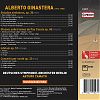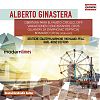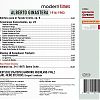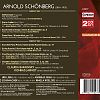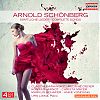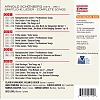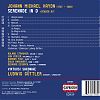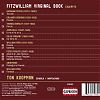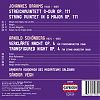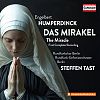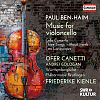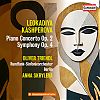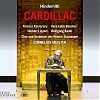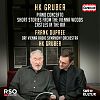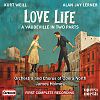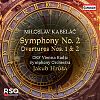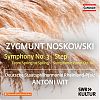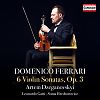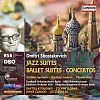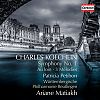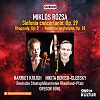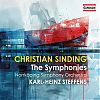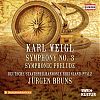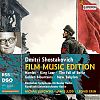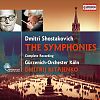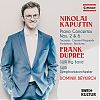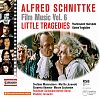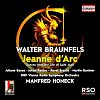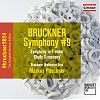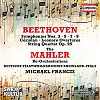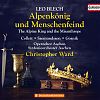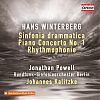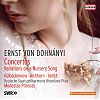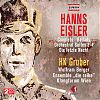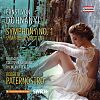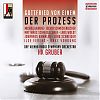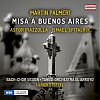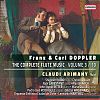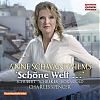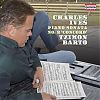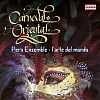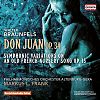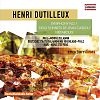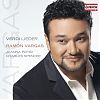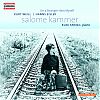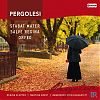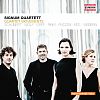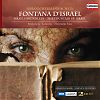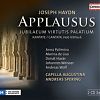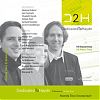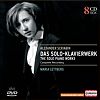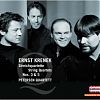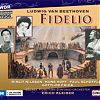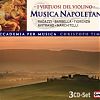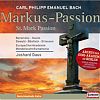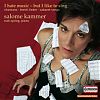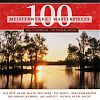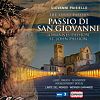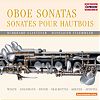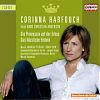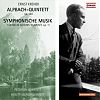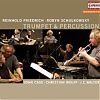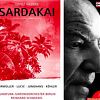cd
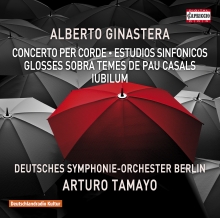
ALBERTO GINASTERA (1916 - 1983)
DEUTSCHES SYMPHONIE-ORCHESTER BERLIN · ARTURO TAMAYO
SOUND SAMPLE
https://soundcloud.com/user-592952001/alberto-ginastera-new-cd
After achieving independence from Spain an autonomous concert and opera life developed in Argentina, in many respects trained in European traditions: Astor Piazolla, the founder of the Tango Nuevo, should be mentioned here, as well as Mauricio Kagel, Carlos Gardel and finally the personality that has been considered for decades the great man of classical-style music in the South American country: Alberto Ginastera. Three of the works recorded here fall into this final period, the ‘Neo-Expressionist’ one. The Concerto per corde op. 33 (1965), held in the classical four movements, Estudios sinfonicos op. 35 (1967), one of Ginaster’s orchestral works experimenting furthest with sytlistic devices of the avant-garde and a special position within the works of the third period is taken by the Glosses sobra temes de Pau Casals op. 48 (1976/77), as it takes recourse to very traditional material – themes by the great Spanish cellist Pablo Casals – treating it in a kind of reflection in an avant-garde mirror.
Weitere Bilder
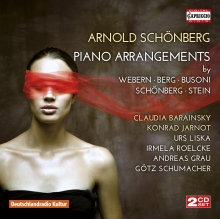
ARNOLD SCHÖNBERG
CLAUDIA BARAINSKY · KONRAD JARNOT · URS LISKA · ANDREAS GRAU· GÖTZ SCHUMACHER · IRMELA ROELCKE
COMPACT DISC 1
Gethsemane (Fragment) · Text: Richard Dehmel
Piano score by / Klavierauszug von Arnold Schönberg
Gurre-Lieder (Orchestral Parts / Orchesterstücke)
Arr.: Anton Webern (1883 – 1945)
for 2 pianos with 4 players / für zwei Klaviere mit 4 Spieler
Six Orchestral Songs / Sechs Orchesterlieder, op. 8
Piano score by / Klavierauszug von Anton Webern
Piano Piece op. 11, No. 2 / Klavierstück op. 11, Nr. 2
arr.: Ferruccio Busoni (1866 – 1924)
COMPACT DISC 2
Six Little Piano Pieces / Sechs kleine Klavierstücke, op. 19
String Quartet / Streichquartett Nr. 2, op. 10
Piano Score by / Klavierauszug von Alban Berg (1885 – 1935)
5 Pieces for orchestra, op. 16
arr.: Erwin Stein (1885 – 1958) / arr.: Anton Webern
Chamber Symphony / Kammersinfonie Nr. 2, op. 38b
arr.: Arnold Schönberg
for 2 pianos with 2 players / für zwei Klaviere mit 2 Spieler
CLAUDIA BARAINSKY, Sopran / soprano
KONRAD JARNOT, Bariton / baritone
Klavier / piano:
URS LISKA · ANDREAS GRAU · GÖTZ SCHUMACHER · IRMELA ROELCKE
After the great success of the complete recordings of the songs by Arnold Schoenberg (Capriccio 4CD-Set, C7120), the pianist Urs Liska and prominent colleagues once more deal with the father figure of Modernism on this double CD. Piano arrangements with up to four players, the majority of them world premiere recordings, show large-scale orchestral works such as the Gurre-Lieder or the Orchestral Pieces op. 16 in a new and transparent light.
Weitere Bilder

JOHANN MICHAEL HAYDN
Virtuosi Saxoniae · Ludwig Güttler
With CAPRICCIO Encore we re-release most famous recordings from the Backcatalogue in a remastered version, new design and for a special price. Legendary recordings of artsts like Sandor Végh, Ton Koopman, Sir Neville Marriner or the Vienna Boys’ Choir are also included as special repertoire highlights from the baroque to the contemporary era.
In July, 1763 Johann Michael Haydn (1737-1806) arrived in Salzburg and promptly gave a performance at the prince bishop's summertime residential palace. It is noted in the court register that the table music was 'furnished by an outside composer from Vienna by the name of Michael Heiden''. Within a year's time, he had been commissioned to write a serenade. In Salzburg one had high expectations of the composer and newly-named (second) concertmaster Haydn, for it was traditionally the most respected composers of the court who received commissions by the university students to write such serenades. It was a custom in Salzburg to pay respects to the prince bishop at the conclusion of exams, usually in August or early September, by playing a serenade, sometimes called a "Finalmusik".
Weitere Bilder

FITZWILLIAM VIRGINAL BOOK
Ton Koopman, harpsichord
With CAPRICCIO Encore we re-release most famous recordings from the Backcatalogue in a remastered version, new design and for a special price. Legendary recordings of artsts like Sandor Végh, Ton Koopman, Sir Neville Marriner or the Vienna Boys’ Choir are also included as special repertoire highlights from the baroque to the contemporary era.
The "Fitzwilliam Virginal Book" would never have been written if Francis Tregian had not been imprisoned in London's Fleet Street jail from 1609 until his death in 1619. Tregian, the offspring of a wealthy Catholic family, had been condemned for rebelling against the English crown. Friends brought him books and musical journals with which to pass the time, and Francis copied them. That is how the great collection – and other works – originated, consisting of 209 compositions for the virginal by various well-known and several lesser-known composers.
Weitere Bilder

BRAHMS: String Quintet SCHÖNBERG: Transfigured Night
Sandor Végh
With CAPRICCIO Encore we re-release most famous recordings from the Backcatalogue in a remastered version, new design and for a special price. Legendary recordings of artsts like Sandor Végh, Ton Koopman, Sir Neville Marriner or the Vienna Boys’ Choir are also included as special repertoire highlights from the baroque to the contemporary era.
To his opponents and detractors, Brahms was for long considered a composer whose powers of invention were handicapped by excessive respect for tradition, and who, in a period of the hegemony of opera and sumptuously sonorous symphonic poems, had squandered his considerable compositional technique on old forms and genres like symphony, folksong, variations and chamber music. Then in 1933 Arnold Schönberg (in "Brahms the progressive") set against the conventional portrait of the musical conservative and imitator the image of the progressive composer who in his works had even demonstrated a new beginning. In his technique of "developed variation" (Schonberg) he formed from narrowly circumscribed material (at the extreme, from a single interval) far-reaching formal connections and replaced the "architectonic " by the "logical" form.


